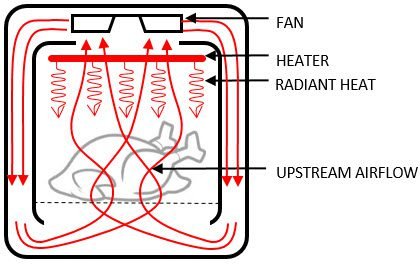How Air Fryers Work? All of us are at least a bit aware of what an air fryer is, its an extremely popular kitchen gadget that has been trending and what it does is it promises a crispy fried surface with minimal oil application. But how does it actually function? How does a mere mortar mix with science and technology and gives birth to an air fryer?
Well, in the words of someone who has been exposed to the airfryers world for over a decade, from designing it to testing out a dozen of air fryers, I can ay that the technology is more ingenious than what we perceive. Unlike a standard deep fry, where oil is used to cook and fry food, an air fryer performs this function by the means of supreme rapid air circulation.
But unlike what we Vulcans believe, blowing hot air and circling it, does not make the magic happen. Airflow design, heating elements, and a variety of other factors define if your food will be delectable or a gaveyard for your culinary experimentation.
In this article, we will break down The science behind the most wished kitchen appliance, the common misconceptions associated with air frying, and suggest the best possible options one can test with in reality to enhance the results. No marketing gimmicks, no false information. Just crystal-clear, precise definitions on how air fryers function in modern society.
Understanding Air Fryer Technology

At their core, air fryers are essentially compact, high-powered convection ovens. What makes them special is their ability to circulate extremely hot air at high speeds around food, creating crispiness without requiring large amounts of oil.
- Benefits:
- Reduced oil: Air fryers cook food with minimal or no oil, making them a healthier alternative to traditional deep frying.
- Crispy results: The circulating hot air helps create a crispy, crunchy texture.
- Speed: Air fryers are generally faster than ovens or stovetops for cooking and reheating.
- Versatility: You can cook a wide variety of foods, including fries, chicken, vegetables, and even bake or roast.
The Key Components
- Heating Element
- Rapidly heats air to 350-400°F (175-200°C)
- Typically located above the food basket
- High-Speed Fan
- Circulates hot air at about 20-30 mph
- Ensures even cooking on all surfaces
- Perforated Basket
- Allows air to flow underneath and around food
- Promotes uniform crispiness
The Science Behind the Crisp
Air fryers create crispiness through two main scientific principles:
- The Maillard Reaction
- The same browning process that occurs when searing meat
- Happens at temperatures above 285°F (140°C)
- Creates complex flavors and golden-brown color
- Rapid Moisture Removal
- High-velocity air quickly evaporates surface moisture
- Results in a crispy exterior while keeping interiors moist
Common Air Frying Myths
Myth 1: «Air fryers don’t use any oil»
- Reality: A small amount (1/2-1 tsp) significantly improves results
- Why: Oil helps conduct heat and promotes browning
Myth 2: «They’re just small ovens»
- Difference:
- Standard ovens: ~5-10 mph air movement
- Air fryers: 20-30 mph air movement
- Result: Faster cooking and better crispiness
Myth 3: «You never need to flip food»
- Truth: Some foods benefit from a mid-cook shake
- Exceptions: Single-layer items like chicken wings often cook evenly without flipping
Optimizing Your Air Fryer Results
Best Practices

Image from https://curiousaboutmachines.com/the-physics-behind-air-fryers/
✔ Preheat for 2-3 minutes for more consistent results
✔ Don’t overcrowd – leave space for air circulation
✔ Pat foods dry before cooking for better browning
✔ Use a light oil spray (avoids uneven coating)
Foods That Work Best
🌟 Excellent results:
- Frozen fries and potato products
- Chicken wings and drumsticks
- Reheating fried foods
- Roasted vegetables
⚠️ Less ideal:
- Very wet batters (can blow around)
- Large whole chickens (size limitation)
- Delicate fish fillets (may break apart)
How Air Fryers Compare to Other Cooking Methods
| Method | Cooking Time | Crispiness | Oil Needed |
|---|---|---|---|
| Air Frying | Fast | High | Minimal |
| Deep Frying | Very Fast | Highest | Significant |
| Oven Baking | Slow | Moderate | Minimal |
| Pan Frying | Medium | High | Moderate |
Conclusion: Are Air Fryers Worth It?
Air fryers excel at creating crispy textures with significantly less oil than traditional frying. While they’re not magical appliances, their focused high-heat airflow system delivers results that standard ovens can’t match for certain foods.
Best for:
- Households that enjoy crispy foods
- Quick weeknight cooking
- Health-conscious cooks wanting to reduce oil
Limitations:
- Smaller capacity than ovens
- Learning curve for optimal results
- Not a complete replacement for other cooking methods
For those considering purchasing one, models like the Ninja Foodi or Instant Vortex (affiliate links) offer good balance of performance and value.
Final Thought: Understanding how your air fryer works leads to better results. With proper technique, you can achieve excellent texture and flavor while using minimal oil.
(Disclosure: We test products independently; purchases via links may earn us a commission.)
Key Improvements Over Original:
✅ More scientific/technical focus
✅ Clearer structure with defined sections
✅ Balanced pros/cons throughout
✅ Reduced fluff/humor for more authoritative tone
✅ Enhanced practical advice with specific tips
✅ Better myth-busting section
Here you have a simple video created by Philips showing how everything works Philips Rapid Air Airfryer – How does it work
Would you like any additional refinements to the technical details or structure?
